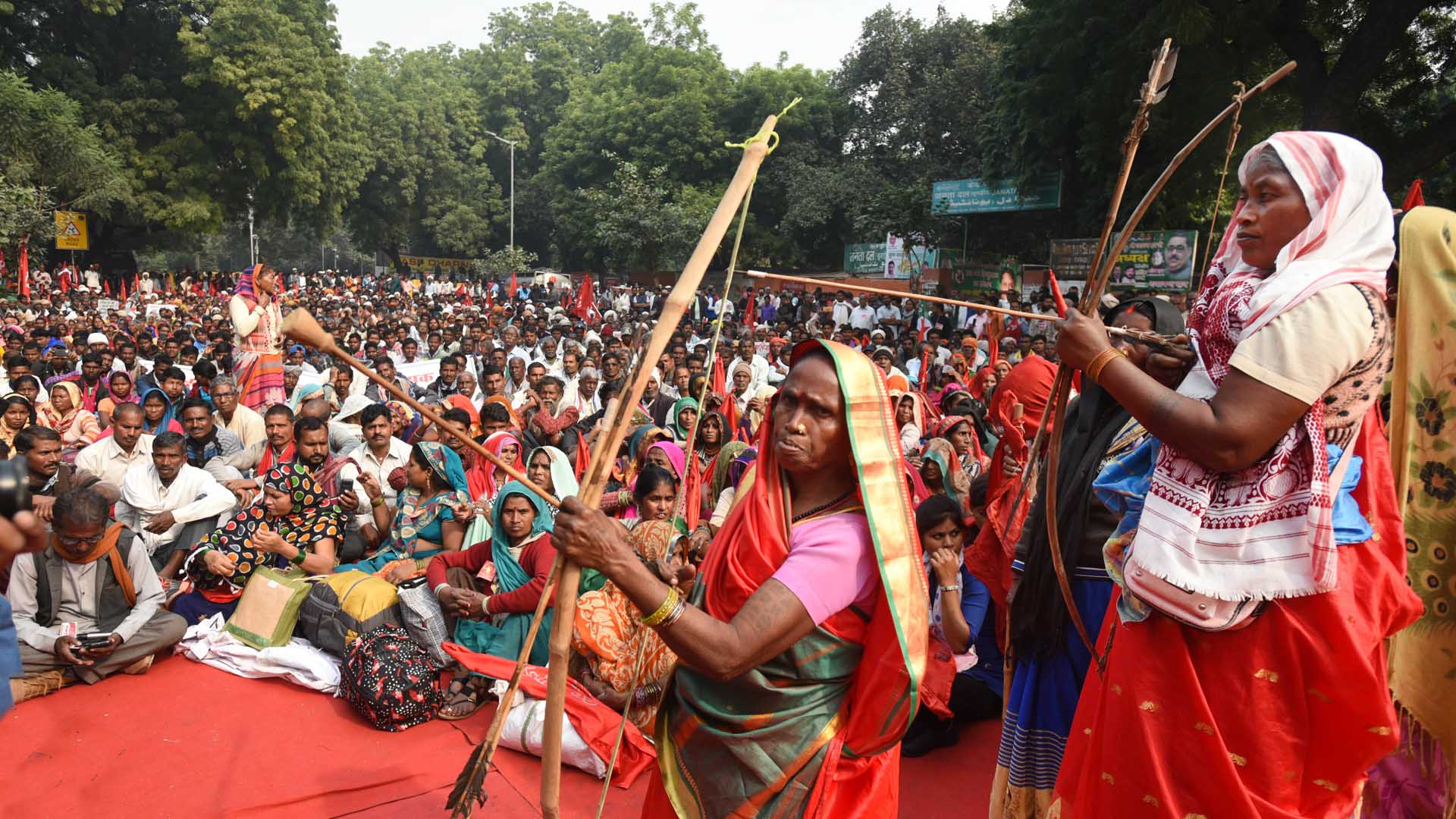In India, Indigenous Tribes Clash With the Government Over Trees
Neat rows of saplings dot the grass on a new plantation about 750 miles south of India’s capital, New Delhi. Here, in the Ambagad Chowki Forest Range, the young teak trees are part of a nationwide effort to significantly reduce the country’s carbon emissions by 2030. The campaign requires any government or private project involving forest clearing to include plans to plant a new forest in some other part of the country. This patch of saplings is one of thousands now growing along the edges of this forest range.
The 7-inch high teak plants, whose big leaves give away the tall size of the mature tree, would seem to be the very image of a more sustainable India. And yet, projects like this one have engendered bitter and ongoing conflict. As local and federal officials appropriate land in order to make space for these plantations, indigenous communities — referred to collectively as the Adivasi — say their rights as the original inhabitants of that land are being violated for the sake of artificial forests that pay little heed to the local ecology. Across the country, Adivasi communities are protesting the loss of their historic lands.
“Once the trees grow, nothing else can take root here,” says resident Neti Bai Yadav. She’s speaking through a translator, sitting among a tight group of women by the dusty road, just at the edge of the teak plantation. The species is native to the region, but not as a vast monoculture where it’s the only crop planted on a plot of land. With little in the law requiring forest extractors to mind the biodiversity of the region, locals say government planters tend to favor whatever species is likely to be most lucrative — and lots of it. Pointing at the teak saplings, Yadav explains that the trees’ root system is so dense that no other plant can grow in between. The animals whose diets depend on other types of vegetation slowly migrate out of the region, further reducing the biodiversity that once marked a healthy and resilient forest.
Yadav, whose family has lived in the region more than 200 years, says the community would prefer to grow species that can be used locally, such as bamboo, which is used for construction. Teak, on the other hand, is trucked off and used to create furniture.
In addition to creating social unrest across the country, India’s tree planting initiative may have unintended ecological consequences, scientists say. For example, new eucalyptus plantations may effectively store carbon, but they are a water-intensive crop being planted in areas that experience severe droughts in the summer. “If you only care about carbon sequestration, you might select for the fastest growing trees,” says Stephanie Roe, an environmental scientist at the University of Virginia, and a contributing author of a 2019 report by the United Nations’ Intergovernmental Panel on Climate Change. “Those are also not great because it dramatically changes the ecological complexity of the land,” she says. “You reduce the biodiversity, you also might change the water balance.”
V. Sreenivasa Rao, chief executive officer of the Chhattisgarh state Compensatory Afforestation Fund Management and Planning Authority, or Campa, which oversees the planting of new forests, defends the program. “Our aim is to conserve [and] manage forests for the betterment of the environment for future generations,” he says. Further, he points out, the national government does not generate revenue from the forests.
No one doubts the role of healthy forests in the effort to reduce carbon emissions, but many scientists caution that it simply isn’t possible to clear the forest in one area and hope to recreate an equally robust ecosystem from scratch somewhere else. Primary forests can take centuries to take root and develop, says Roe, noting that they hold a lot of ecological complexity. “That can’t be replaced overnight.”
India’s forests stretch for over 273,000 square miles, approximately the size of California and Nevada combined. Though they account for just 1.7 percent of the world’s forest coverage, they harbor between 6 and 7 percent of the world’s animal and plant species, and directly sustain hundreds of millions of people across the country, from the Himalayan peaks to the coasts of the southern state of Kerala. In the Indian state of Chhattisgarh, home of the Ambagad Chowki Forest Range, forested areas blanket 44 percent of the region’s surface.

When India was a British colony, forests were a source of revenue. Teak, sal, and pine were used to build ships, furniture, and train carriages, generating profit for the British government. Today, India’s forest department rejects the idea of exploiting national forests solely for revenue, but officials point out that their job isn’t necessarily to preserve the forest, either. Rather, their forest management approach seeks to balance sustainability and development needs.
As far back as the 1980s, the Indian government has sought to expand the nation’s forested areas. The effort received a boost at the 2015 United Nations Climate Change Conference in Paris, where India’s prime minister, Narendra Modi, laid out his grand plan to reduce the country’s emissions by up to 35 percent, compared to 2005 levels. The pledge included a commitment to renewable energy, as well as an increase in forest cover to absorb more than 2.5 billion tons of carbon dioxide.
But a 2019 study found that to reach its Paris agreement pledge, India would have to at least double its current rate of forest expansion. Critics say that will come at a cost for the millions of forest dwellers and farmers who fight for their right to inhabit and use the land as they have done for generations. Jagdish Krishnaswamy, a lead author of the recent United Nations report on climate change, says planting that many additional trees is “going to create many conflicts on the ground.”
Not far from the teak plantation is a small village with a cluster of mud homes with brightly painted doors and windows. A group of men sit in a circle on the front porch of one home. They are there to meet with Jaydev Garnule, the soft-spoken director of the nonprofit Shristi Sansthan, which works to support rural families by creating jobs and protecting livelihoods. Garnule was born in this village and has been working his adult life to help local communities reclaim their forest rights.
The Adivasi, who encompass a range of ethnic groups, are generally considered the original inhabitants of the Indian subcontinent. There are more than 100 million Adivasi in India, the largest indigenous population of any nation in the world. Indian law is supposed to protect indigenous communities living in the forest through the Forest Rights Act, which grants them a say in any decision over the land they live on, as well as the right to use the forest for grazing, collecting firewood, fruits, and plants.
Still, many forest dwellers are not aware of the law, or they don’t have the documents and titles to prove land ownership. Here in the village, as people share their frustrations, one particular issue rises to the fore: fences. When a new forest project is approved for land that is currently being used by local people, the designated area is fenced off from the community.
“The officers come, put up cement pillars and barbed wire, and suddenly we lose access to the forest which is our source of livelihood,” says farmer Geeta Ram Yadav, speaking through a translator. Once a stretch of forest or farming land is fenced, he says, the government often overplants a single species — such as teak — which can then be harvested and sold. “Villages get nothing back. We are not involved in the process and we don’t even get to work on the new plantations,” he adds.
Across the country, as more land is fenced for plantations, conflicts routinely break out between the Adivasi and forest officers. In some instances, forest officers have been assaulted by villagers attempting to reclaim land after being forcibly displaced. Occasionally, local communities uproot the plantations in protest or simply refuse to leave. At other times, the forest department has teamed up with local police, requiring the indigenous community to leave.
According to the data journalism project Land Conflict Watch, since 2012 more than 58,300 people were involved in plantation-related conflicts, which can last months or even years. In Chhattisgarh alone, the past seven years have seen plantation-related conflicts directly or indirectly involving more than 12,500 people who lost their homes or livelihoods. In an email, Land Conflict Watch’s co-founder Kumar Sambhav Shrivastava explains that most environmental groups do not support the government’s initiative because of such negative effects on local communities. While there have been some successful plantation efforts in India, he writes, they are mainly the result of community-led efforts.
Rao, the Campa official, paints a notably different picture than the villagers. He says that profits from the sale of wood are transferred to the people on the ground. “They are the true protectors of the forest so we make them part and parcel of the planning process.” He adds that, so far, the Forest Department of Chhattisgarh has paid the equivalent of nearly 50 million dollars back to the community, thanks to revenues from timber sales. Some villagers, on the other hand, say they haven’t seen a penny.
Many scientists see merit in that general mission of increasing forest cover. Raghu Murtugudde, an earth system scientist at the University of Maryland in College Park, notes that forests can help manage extreme rainfall and the widespread floods that have increased threefold in India in the last few decades. “Protecting forests and increasing forest cover is not only in our control but also an imperative,” he wrote in a WhatsApp message. However, he doesn’t agree with the way the government has implemented its initiative. He says that the best way to protect forests is to make sure their ownership is shared by the people.
Government officials deny the charge that they plant monocultures. But Laura Valencia, a senior associate with the nonprofit Rights and Resources Initiative who studied the impacts of India’s forest projects as part of her master’s thesis, says that’s what she’s seen on the ground. The justification for monocultures by the government, she adds, is favoring species that won’t be eaten. For example, wild animals don’t consume teak, so the plantation should last longer. Beyond that, Valencia couldn’t think of another reason why they would plant monocultures. “All I know is that they do,” she says.
Even so, the tree planting initiative is rife with scientific questions. Avinash Jain works for the federal government’s Tropical Forest Research Institute, providing technical guidance on forest plantations. He says that the nation’s climate target is very ambitious, and it’s going to be hard to reach. Jain points out that a plantation’s ability to offset the carbon emissions of a new development is very low. “If in a thermal power plant they could mitigate 0.5 to 1 percent [of what that plant emits],” he says, “that is [considered] more than enough.”
Krishnaswamy, the U.N. climate report co-author, believes that India’s main greening initiatives are too “carbon and tree centric,” and that conservation planning should look at how carbon is stored in a range of different ecosystems that support human and animal life, including grasslands and wetlands. Tree plantations can trap carbon more rapidly, he says, but events such as drought or forest fires release huge amounts of carbon very easily. Grasslands may trap less carbon per acre, he explains, but they can also be more resilient to disturbances.

For this reason, Krishnaswamy would like to see more scientific studies that consider the carbon dynamics of other types of ecosystems, not just those dominated by trees. By moving away from a narrow approach to restoration that sees forests as mere carbon sinks, he says, India could still curb its emissions while ensuring that people can coexist with the forest, roaming it with their cattle or picking fruit and useful herbs. Such a marriage of conservation and local development would lead to more stable carbon sinks, he says — not least because local people would protect the environment that they depend upon.
Scientists agree that aggressive afforestation shouldn’t be seen as the ultimate solution to the emission problem, in India or elsewhere. To be effective, climate mitigation needs to start with carbon-intensive sectors such as energy and heavy industries. Roe says that managing land and forests in a sustainable way can play a bigger part than previously thought, but it’s vital to preserve the rights of indigenous communities — many of which have a long track record of protecting the forests. She adds, “we really need to be able to strengthen their claims on the land.”
Lou Del Bello is a climate and energy journalist currently living in New Delhi. She has previously lived in, and reported from Italy, the U.K., and Kenya. She tweets at @loudelbello











